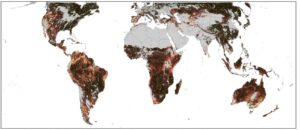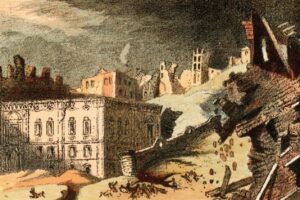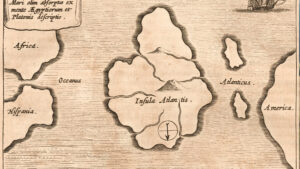Can a continent disappear? Many cultures have stories of vanishing islands or cities swept away by tidal waves. But is there truth to any of these legends?
Our continents have undergone tumultuous periods of shifting, converging, diverging, and subducting. With these geological processes, continents broke apart. Occasionally, we find remnants of ancient continents. Scientists have been searching for one of these, called Argoland, for decades. They might have finally found it.
Paleocontinents
When we talk about submerged continents or lands, we refer to continental crust in our oceans. These landmasses could be the source of “lost land” stories in numerous cultures, such as Atlantis, Lemuria, and Thule.
Landmasses from Earth’s distant past are split into cratons, supercratons, microcontinents, continents, and supercontinents. Gondwana, Laurentia, Pangea, and Rodinia were supercontinents. Broken apart by plate tectonics, they became continents, which sometimes broke into smaller microcontinents.
We have found microcontinents and cratons around the globe. Scientists identified Madagascar and Seychelles as microcontinents of the Gondwana supercontinent. Other islands, like the Azores and Socotra in Yemen, are pieces of Pangea.

Plate tectonics map. Photo: M.Bitton
Some of Earth’s early landmasses were gradually submerged, others subducted — slipped below — into the Earth’s mantle. Others pushed up to form islands and mountains.
What is Argoland?
Argoland was a continent that purportedly split from northwestern Australia before drifting northwest toward Southeast Asia. Its disappearance left a void in the ocean off the northwestern coast of Australia. No one definitely knew where it went. In theory, it could have settled under Indonesia and Myanmar. Argoland existed during the reign of the dinosaurs and was supposedly 4,800km long and the width of the United States.
Normally, when a landmass moves, it leaves behind a sort of signature. This signature is usually underwater mountain ranges, fossilized wildlife, and other large areas of land underwater. But Argoland did not leave obvious clues.
The search for Argoland
Eldert Advokaat and Douwe van Hinsbergen from the University of Utrecht are key figures in the search for Argoland. They believe that the continent split, creating an oceanic basin called the North Australian Basin or Argo Abyssal Plain. It is 5,730m deep and possesses some magnetic anomalies. For Advokaat and van Hinsbergen, this indicated that something once occupied this space. They launched their search in 2017.
Van Hinsbergen discovered Greater Adria in 2019. This continent broke off from North Africa, splintered into multiple pieces, and settled in the Mediterranean. Pieces can be found all over Europe, including the Balkans, Alps, Anatolia, and Iberia.
Meanwhile, Advokaat had been documenting rocks on the Indonesian island of Sulawesi, believing it held the key to unlocking a missing part of our geological history.
They believe Argoland began to break away some 300 million years ago when Gondwana was still a supercontinent. It finally broke away from northwestern Australia 155 million years ago during the Late Jurassic Period.

A reconstruction of Argoland. Photo: Utrecht University
Far-flung fragments
Remnants of Argoland lie in Southwest Borneo, Greater Paternoster, East Java, West Burma, and Mount Victoria Land. Advokaat and his team excavated these areas.
Advokaat and van Hinsbergen realized that bits and pieces of Argoland were hiding in layers of rock that differed in age, making it hard to distinguish. They had expected to find a single buried landmass. Instead, rock from different ages was muddled together.
In their study, Advokaat and van Hinsbergen argue that Southeast Asia includes relics of a major continent. As plate tectonics shifted, upheaved, and subducted pieces of the Earth’s crust, the process created a deformed, long-lived belt of the Earth’s crust called an orogen. This orogen formed during a long, chaotic period of 100 million years.
By evaluating the western and northwestern Australian margins and formations throughout Myanmar, Indonesia and Malaysia, the team managed reconstruct the tectonic movements of Argoland. This reconstruction showed Argoland’s trajectory for Southeast Asia as the Northwest Australia Margin was subjected to an eons-long period of ocean spreading, continental extension, and then subduction. As a result, pieces of land were uplifted and lie within those Southeast Asian islands.
Chaotic and messy
Not all continents which separate make such a clean break from South America and Africa, says science writer Cassidy Ward. In the case of Argoland, things got chaotic and messy. Therefore, Argoland was not a large, solid landmass but a chain of islands, an archipelago. The pair have affectionately named it “Argopelago.” This archipelago formed as the bigger landmass was breaking off of Australia.
The continent of Great Adria suffered a similar fate. It fragmented so much that you can find pieces all the way from the Iberian Peninsula and the Mediterranean to Western Asia! The painstaking search for remnants lasted more than a decade. Greater Adria supposedly spun and collided into other landmasses, sending a thick chunk of the Earth’s crust into the mantle. The rest you can find in strips in the Pyrenees, Occitania, the Alps, Anatolia, and the Caucasus. It was supposedly the size of Greenland at one point.
More continents await
The search for ancient continents never stops. In 2017, scientists discovered a lost continent called Mauritia beneath the surface of Mauritius. It lay between India and Madagascar on Gondwana before the supercontinent split up. After the separation, Mauritia broke into even smaller pieces which can be found in Mauritius, Réunion and the Saya de Malha Bank. Researchers detected it by analyzing the zircon crystal deposits in Mauritius, indicating that they originated from continental crust. There was also a gravitational anomaly which usually signals a much larger, hidden landmass.
As of 2023, geologists completed mapping Zealandia, a land that broke off of Gondwana over 80 million years ago. Most of it is underwater. New Zealand is part of this massive landmass.
Conclusion
After the discoveries of Argoland, Greater Adria, Zealandia, Mauritia and other ancient continents, it is most likely that others remain hidden. These studies have given us leads for a more thorough search. We have better indicators now, like the zircon crystals and magnetic and gravitational anomalies. We also have a firmer understanding of the land’s movements.
Many submerged lands turned out to be more fragmented and ribbon-like than predicted. Therefore, scientists need to put aside their preconceived notions of what the Earth used to look like in order to find more of our geological past.






